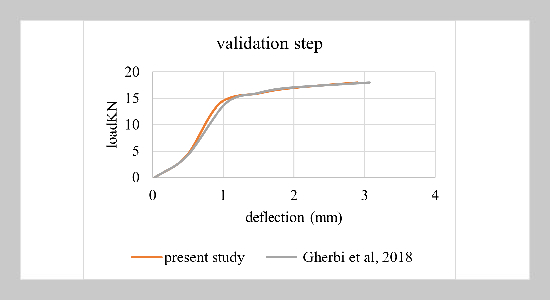- [1] M. Tagba, S. Li, M. Jiang, X. Gao, M. L. Benmalek, S. Boukour, and C. Liu, (2021) “Performance Evaluation of Cementitious Composites Containing Granulated Rubber Wastes, Silica Fume, and Blast Furnace Slag" Crystals 11(6): 632.
- [2] B. H. Al-Humeidawi, (2014) “Utilization of waste plastic and recycle concrete aggregate in production of hot mix asphalt" Al-Qadisiyah Journal for Engineering Sciences 7(4): 322–330.
- [3] G. Li, M. A. Stubblefield, G. Garrick, J. Eggers, C. Abadie, and B. Huang, (2004) “Development of waste tire modified concrete" Cement and Concrete Research 34(12): 2283–2289.
- [4] O. Y. Marzouk, R. Dheilly, and M. Queneudec, (2007) “Valorization of post-consumer waste plastic in cementitious concrete composites" Waste management 27(2): 310–318.
- [5] A. Benazzouk and M. Queneudec. “Durability of cement-rubber composites under freeze thaw cycles”. In: Proceeding of International congress of Sustainable Concrete Construction, Dundee-Scotland. 2002, 355–362.
- [6] K. A. Paine, R. Dhir, R. Moroney, and K. Kopasakis. “Use of crumb rubber to achieve freeze thaw resisting concrete”. In: Proceedings of the International Conference on Concrete for Extreme Conditions, University of Dundee, Scotland, UK. 2002, 486–498.
- [7] B. Z. Savas, S. Ahmad, and D. Fedroff, (1997) “Freezethaw durability of concrete with ground waste tire rubber" Transportation Research Record 1574(1): 80–88.
- [8] F. Hernández-Olivares and G. Barluenga, (2004) “Fire performance of recycled rubber-filled high-strength concrete" Cement and concrete research 34(1): 109–117.
- [9] S. Yang, B. H. Kjartanson, and R. A. Lohnes, (2001) “Structural performance of scrap tire culverts" Canadian Journal of Civil Engineering 28(2): 179–189.
- [10] L. AYADI, (2015) “CHAMBRE SYNDICALE NATIONALE DES GROSSISTES IMPORTATEURS DE PNEUMATIQUES":
- [11] A. Elghazouli, D. Bompa, B. Xu, A. Ruiz-Teran, and P. Stafford, (2018) “Performance of rubberised reinforced concrete members under cyclic loading" Engineering Structures 166: 526–545.
- [12] N. Tangboriboon, P. Phudkrachang, L.-o. Mulsow, W. Kunchornsup, and A. Sirivat, (2013) “Removal of water extractable proteins from concentrated natural rubber latex by eggshells" Journal of Elastomers & Plastics 45(3): 253–269.
- [13] P. E. Sebaaly, V. T. Gopal, and M. Ardila-Coulson. Impact of Crumb Rubber and Other Fillers on the Rheological Properties of Binders. Tech. rep. 2000.
- [14] D. Yerezhep, A. Tychengulova, D. Sokolov, and A. Aldiyarov, (2021) “A multifaceted approach for cryogenic waste tire recycling" Polymers 13(15): 2494.
- [15] M. Myhre, S. Saiwari, W. Dierkes, and J. Noordermeer, (2012) “Rubber recycling: chemistry, processing, and applications" Rubber chemistry and technology 85(3): 408–449.
- [16] A. Isayev and J. Oh, (2005) “Tire Materials: Recovery and Re-use" The Pneumatic Tire 18: 670–691.
- [17] W. K. Dierkes, K. Dijkhuis, H. v. Hoek, J. Noordermeer, L. Reuvekamp, S. Saiwari, and A. Blume, (2019) “Designing of cradle-to-cradle loops for elastomer products" Plastics, Rubber and Composites 48(1): 3–13.
- [18] A. Macsiniuc, A. Rochette, and D. Rodrigue, (2013) “Effect of SBR rubber particle size distribution on its thermo-mechano-chemical regeneration" Progress in Rubber Plastics and Recycling Technology 29(4): 217–238.
- [19] S. Saiwari, J. W. Van Hoek, W. K. Dierkes, L. E. Reuvekamp, G. Heideman, A. Blume, and J. W. Noordermeer, (2016) “Upscaling of a batch de-vulcanization process for ground car tire rubber to a continuous process in a twin screw extruder" Materials 9(9): 724.
- [20] I. Löfgren, (2005) “Fibre-reinforced concrete for industrial construction" Göteborg: Chalmers:
- [21] C. Aire, C. Mendoza, and P. Davila. “Polypropylene fibers reinforced concrete: Optimization on plastic shrinkage cracking”. In: Proceedings of the Second International Conference on Future Concrete, Abu Dhabi, United Arab Emirates. 12. 2011.
- [22] A. Singh and S. Bhowmik. “Use of Plastic Waste in Bitumen”. In: Smart Cities and Machine Learning in Urban Health. Ed. by J. Thomas, V. Geropanta, A. Karagianni, V. Panchenko, and P. Vasant. IGI Global, 2022, 156–188. DOI: 10.4018/978-1-7998-7176-7.ch008.
- [23] M. A. H. Al-Jumaili. “Sustainability of asphalt paving materials containing different waste materials”. In: IOP Conference Series: Materials Science and Engineering. 454. 1. IOP Publishing. 2018, 012176.
- [24] M. Di Prisco, G. Plizzari, and L. Vandewalle, (2009) “Fibre reinforced concrete: new design perspectives" Materials and structures 42: 1261–1281.
- [25] J. C. Walraven, (2009) “High performance fiber reinforced concrete: progress in knowledge and design codes" Materials and Structures 42(9): 1247.
- [26] A. De la Fuente, P. Pujadas, A. Blanco, and A. Aguado, (2012) “Experiences in Barcelona with the use of fibres in segmental linings" Tunnelling and Underground Space Technology 27(1): 60–71.
- [27] L. Liao, A. de la Fuente, S. Cavalaro, and A. Aguado, (2015) “Design of FRC tunnel segments considering the ductility requirements of the Model Code 2010" Tunnelling and Underground Space Technology 47: 200–210.
- [28] S. L. Suhaendi and T. Horiguchi, (2005) “Fiberreinforced high-strength concrete under elevated temperature-effect of fibers on residual properties" Fire Safety Science 8: 271–278.
- [29] Z. Li, M. Wu, J. Wu, Y. Cui, and X. Xue, (2020) “Steel fibre reinforced concrete meso-scale numerical analysis" Advances in Civil Engineering 2020: 1–16.
- [30] G. Batson, (1976) “Steel fiber reinforced concrete" Materials Science and Engineering 25: 53–58.
- [31] W. Bu, (2008) “Punching shear retrofit method using shear bolts for reinforced concrete slabs under seismic loading":
- [32] J. E. Shoenberger and J. G. Tom. Polypropylene Fibers in Portland Cement Concrete Pavements. Tech. rep. ARMY ENGINEER WATERWAYS EXPERIMENT STATION VICKSBURG MS GEOTECHNICAL LAB, 1992.
- [33] Y. Singh, S. Singh, and H. Singh. “Effect of Steel Fibers on the Sorptivity of Concrete”. In: Fatigue, Durability, and Fracture Mechanics: Proceedings of Fatigue Durability India 2019. Springer. 2021, 479–491.
- [34] Z. I. Khayoun, H. M. Kamal, and Y. K. Ibrahim, (2020) “The effect of hybrid fibers reinforcement on the mechanical and physical properties of concrete" The Open Civil Engineering Journal 14(1):
















